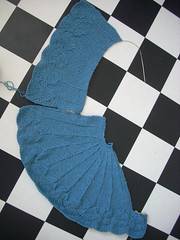Kose (Visjö wool from Östergötlands ullspinneri) is a favourite colourway of mine, changing gradually from brown to different shades of green - beautiful on its own but in my opinion even more so against a neutral background like very light grey. Got the colour combination. Pattern next.
 |
| Labyrinth pattern |
Marianne Isager (ever read that name here before?) has designed quite a few garments using mosaic knitting and slipped stitches, for example a child's sweater "Labyrinth" in her book Inca Knits. I always loved Greek key patterns, and this one works well with the Kose colour changes.
 |
| Rice fields pattern |
For comparison I also cast on to try (a modified version of) Isager's "Rice Fields" from Japanese Inspired Knits, and must say I prefer it in spite of my love of Greek keys: the structure adds an element I like, and the overall effect will be a lot lighter. But what really made it an easy, practically natural, decision was the Japanese key word.
You see, I suddenly remembered why they named this colourway Kose: Chie Kose is a Japanese designer who asked the spinnery for this particular combination of these particular shades. Joining the two Japanese aspects felt like the obvious choice - and in my book a whiff of Danish never hurts.























